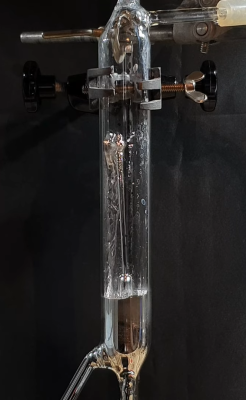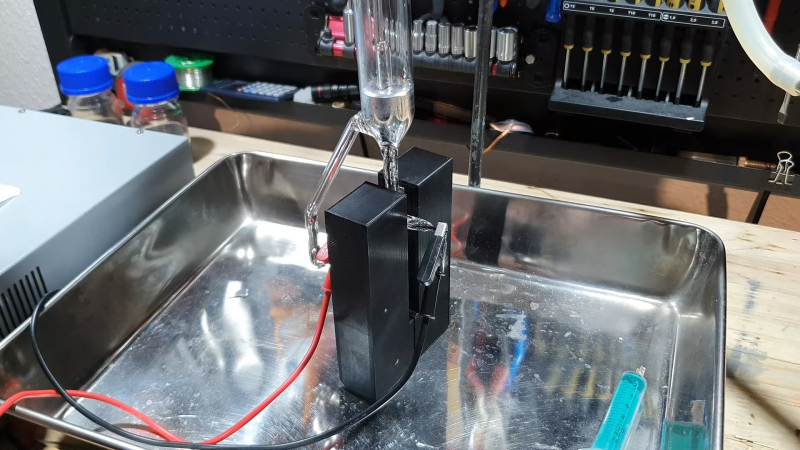A fountain is a great way of adding a little flair to an otherwise boring pond. All you need is a pump, a filter and some pipes, along with a nozzle to scatter the pressurized water in some aesthetically pleasing way. Fountains are generally quite safe: if any of the parts malfunction, the worst thing that can happen is some minor flooding.
How different this is for [Advanced Tinkering]’s recent project, the NaK Fountain. If this one were to spring a leak, it’s quite likely to take out its surroundings in a huge fireball. That’s because the fluid inside is an alloy of sodium and potassium in about a 1:3 ratio, known as NaK (pronounced like “knack”), which is a liquid at room temperature. Unfortunately, it’s also highly reactive: NaK oxidizes quickly when exposed to air and can even catch fire spontaneously. Contact with water will result in a fiery explosion that scatters corrosive liquids everywhere.
 [Avanced Tinkering] therefore built the whole setup inside a custom-made glass enclosure. In his video (embedded after the break) he shows off his glass-blowing skills to make a small nozzle inside a larger glass tube that acts as a reservoir, with a pipe bringing the liquid back to the nozzle. Also embedded in the glasswork are two tungsten electrodes that serve to implement a rather unusual type of pump.
[Avanced Tinkering] therefore built the whole setup inside a custom-made glass enclosure. In his video (embedded after the break) he shows off his glass-blowing skills to make a small nozzle inside a larger glass tube that acts as a reservoir, with a pipe bringing the liquid back to the nozzle. Also embedded in the glasswork are two tungsten electrodes that serve to implement a rather unusual type of pump.
This magneto-hydrodynamic pump works thanks to the Lorentz force. The two electrodes are used to pass a current through the liquid metal in the x direction, while a pair of neodymium magnets positioned just outside provide a magnetic field oriented along the y axis. The Lorentz force then acts upon the liquid in the z direction, pushing it up through the nozzle. Such a pump is convenient when dealing with highly reactive liquids, because it doesn’t require any moving parts that could leak or corrode.
[Advanced Tinkering] went through a few iterations for his glasswork, trying out different pipe orientations and ways to seal the electodes. A vacuum pump was used to remove all traces of moisture and oxygen, with argon providing an inert atmosphere for the NaK to flow freely without accumulating oxides. The end result is quite impressive: a jet of liquid metal that seems to reach about 15 cm in height.
If you’d like to try this yourself (which we obviously don’t recommend), there’s a reasonably easy way to obtain metallic sodium. You’ll also need to learn some glassblowing, which isn’t as hard as it may seem.















This seems identical to this demonstrator: https://youtu.be/9EGAXOWpGy8
Yes, and in his video [Advanced Tinkering] says that’s what he was trying to replicate. The original was disassembled because it was deemed too dangerous with all of that reaction-prone NaK.
So hear me out… A nuclear reactor, we’ll fill it with this stuff, and some highly enriched uranium… And we’ll shoot it in to space. It’s going to be FINE.
Why send it to space? We have already used NaK for cooling reactors here on earth, here’s an example of an early one: https://en.wikipedia.org/wiki/Experimental_Breeder_Reactor_I
What a dumb click-bait stunt. If you must make a liquid metal fountain, choosing very dangerous materials to do it is stooopid! Use tepid liquid metallic gallium instead. Gallium metal melts at 29.7646 °C, 85.5763 °F.[1] At [2] is a short clip showing liquid Gallium droplets coalescing. Metallic gallium is non-toxic and non-combustible. Anyone can easily buy metallic gallium over the counter.[3] Warnings: (a) Gallium expands when it freezes, so don’t store it in a glass container. Use a pliable plastic (e.g. Nalgene) container instead. (b) When in contact Gallium will spontaneously and permanently alloy with other metals such as aluminum, weakening and/or discoloring them. So do not spill a bunch of gallium in an aluminum aircraft.
* References:
1. Gallium
https://en.wikipedia.org/wiki/Gallium
2. Gallium Drops. Ogg Vorbis container should open and play in your browser. At-least Firefox works for me.
https://en.wikipedia.org/wiki/File:Gallium_drops.ogv
3. Gallium Metal 50 Grams, 99.99% Pure Melting Gallium – 50g Vial Amazon’s Choice for “gallium metal” $36.99
https://www.amazon.com/Gallium-Metal-Grams-99-99-Melting/dp/B07P7JN6VR
Ok, let me clarify a few things (since it seems like you don’t really know what you are talking about).
It was done as a homage to the pump that periodic videos showed in their video. So using gallium would not have been the same.
Besides that, there are several problems with gallium:
1. It is over five times more dense than NaK. You would have to put a lot more power through the fountain to get it to work properly. I don’t even think it would be feasible without overheating.
2. Gallium sticks to glass. You would either have to coat the glass with a galliumoxide layer or use absolutely pure gallium and prevent any oxidation.
3. The density of liquid gallium is higher than solid gallium. Which means that if the gallium solidifies in the fountain, it will crack the glass and destroy it.
Yes, but you don’t need the glass with gallium. It’s not reactive with air.
Why not use gallium?
Because it’s solid at room temperature?
Gallium and Mercury do not have built-in flashy explosion effects
86 F is above what is considered room temperature (in most of the world). https://en.wikipedia.org/wiki/Room_temperature
Some of the Gallium alloys like Galinstan have melting points well below room temperature (and below 0°C). Likely more expensive per unit volume than NaK, but certainly less sporty when exposed to atmospheric air.
gallium mixed with indium and tin is liquid in room temperature, used in thermometers
Interesting motor. Conductive, material that generates magnetic field when current passes. Nice use of magnets. wonder if it would function without the insulator turbing/glass or if the current would disapate to housing to quickly. Could you drive the solution with an AC motor with an induced magnetic field?
The most dangerous liquid metal fountain would be made of cesium, of course, NaK is mildly reactive, in comparison :D
It isn’t often that one gets to say this but: Why not switch to using mercury to make is less dangerous?
Mercury is over 12 times more dense than NaK. You would need a lot more power to create a fountain.
And another question is how you define “dangerous”. I would rather work with a very reactive metal than a toxic one.
Metallic mercury isn’t all that dangereous. I am old enough that we had bottles of it in the science lab at school, and have even put my hands into a tub of it (fun and interesting sensation). We were still using it in the indicators of Instron tensile testing machines when I was working at Sheffield University in the 1990s.
As a small boy I found a battery in the road that was oozing mercury. I made myself a little container for my new-found treasure, out of lead foil. And that is when I learned about Amalgums.
Calder already did it
https://theculturetrip.com/europe/spain/articles/calder-mercury-fountain-the-worlds-most-beautiful-yet-deadly-monument/
That was my thought too.
The late Professor Eric Laithwaite discussed this very point in one of his books, possibly “Propulsion Without Wheels”. He worked on the cooling system for Britain’s fast-breeder reactor system, which used either NaK or some similar liquid metal alloy. They couldn’t have turbine blades to pump it, so they ran the coolant through a linear motor, which was his speciality. For lecture hall demonstrations he did make a mercury “fountain”, but it was less successful because mercury is less conductive.
Sorry but I have to ask. What made Professor Laithwaite late?
He died in 1997.
To heavy. Not fancy. I build a liquid Lithium fountain years ago. Very fancy. It is very towed to any oxide or nitride. So no glas in contact with the melt. Only one on top for watching.
I may build something similar one day, but for selective soldering.
At least I now know how these magneto-hydrodynamic pumps work.
@17:56 he says (and shows) about 30A @3V, so these things need quite a bit of current.
Only thing left is what sort of material to use for the pump. I don’t like glass much because it’s so brittle. I guess a piece of teflon will work.
Well, he certainly has a knack for building liquid metal fountains!
(Rimshot!)